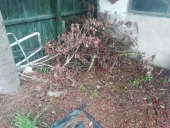Greetings everyone,
By way of quick introduction:
Hello, and thank you for reading my post!
I'm still pretty new to permaculture. I'm a certified California Naturalist, half witted vegetable gardener, and long time native plant gardener....although all of this is my second field of study, and there's soooooooo much to learn!
So I'd say I'm not a total newbie; but in all honesty with respect to permaculture, I'm RIGHT next door to a total newbie.

I'm located in zone 12b in Southern California, USA.
That said, I have these new raised garden beds. Two of them.
They're 8'x4'x2.5'.
The reason I'm doing raised beds is that my soil has tested with some lead in it, so I'm moving my root crops and leafy greens to raised beds, while I attempt to dilute the lead with lots of mulch, lock it up with potash, and also bio-remediate with brassica, sunflowers and scented geraniums.
But that's kind of a tangent (it's all connected, right?)
So I'm looking for wood to hugulkulture my raised beds. I have maybe around 10-12 cubic feet of ash tree that was cut from my property three years ago. Obviously that's already at the bottom of my two beds right now. I know what it is, it's nontoxic and it's aged.
But I need a lot more wood! I can't put in the soil and
compost I have until I solve this wood issue.
I picked up this wood from one of my neighbors (see photos). Apparently someone hacked the heck out of this tree, just last weekend.
All she could tell me is that it is "some sort of Asian tree" and the wood seems to have no sap.
Posting on iNaturalist and asking my local arborist did not yield any results as to what kind of tree this might be.
Since my beds are so large, and since hugulkulture has such great benefits, I do want to put a bunch of wood in the bottom of my beds.
In this large urban environment, I'm having difficulty finding good wood for this purpose.
Does anyone know what kind of tree this is?
If this is decent wood for hugulkulture, could I go ahead and put the wood in the bottom of my beds even though it's fresh cut?
Is it a resprouting risk, or risk of leaking plant-killing chemicals?
If it's a few feet down near the bottom of the beds (with plenty of soil between it and the plants) would that be OK?
I have both heartwood and smaller branches.
Thank you so much in advance for any suggestions.
This is a biiiiiiiig forum/website, it's kind of overwhelming, but I'm looking forward to diving into it. I think if I read/knew 1/8 of the things on here, I could be a Permie PhD!








